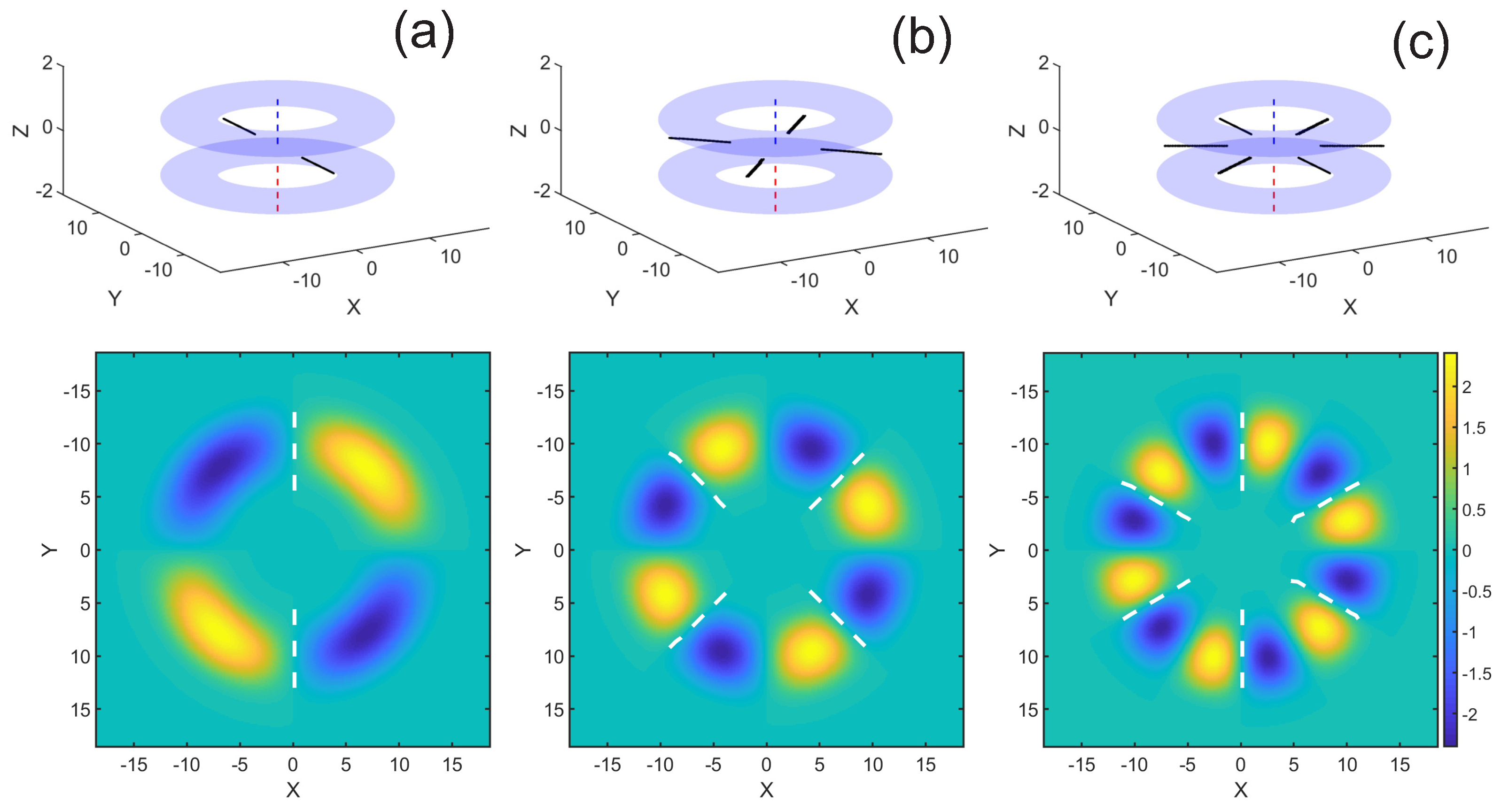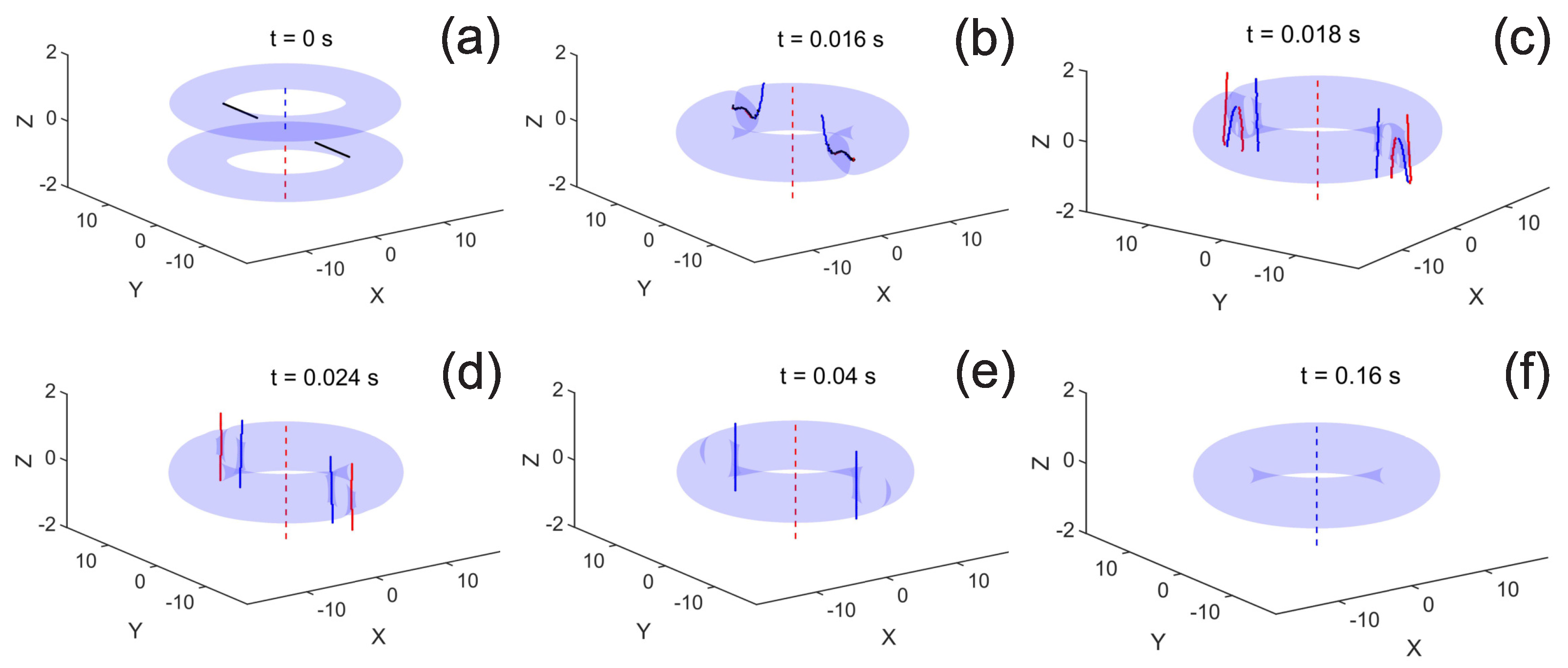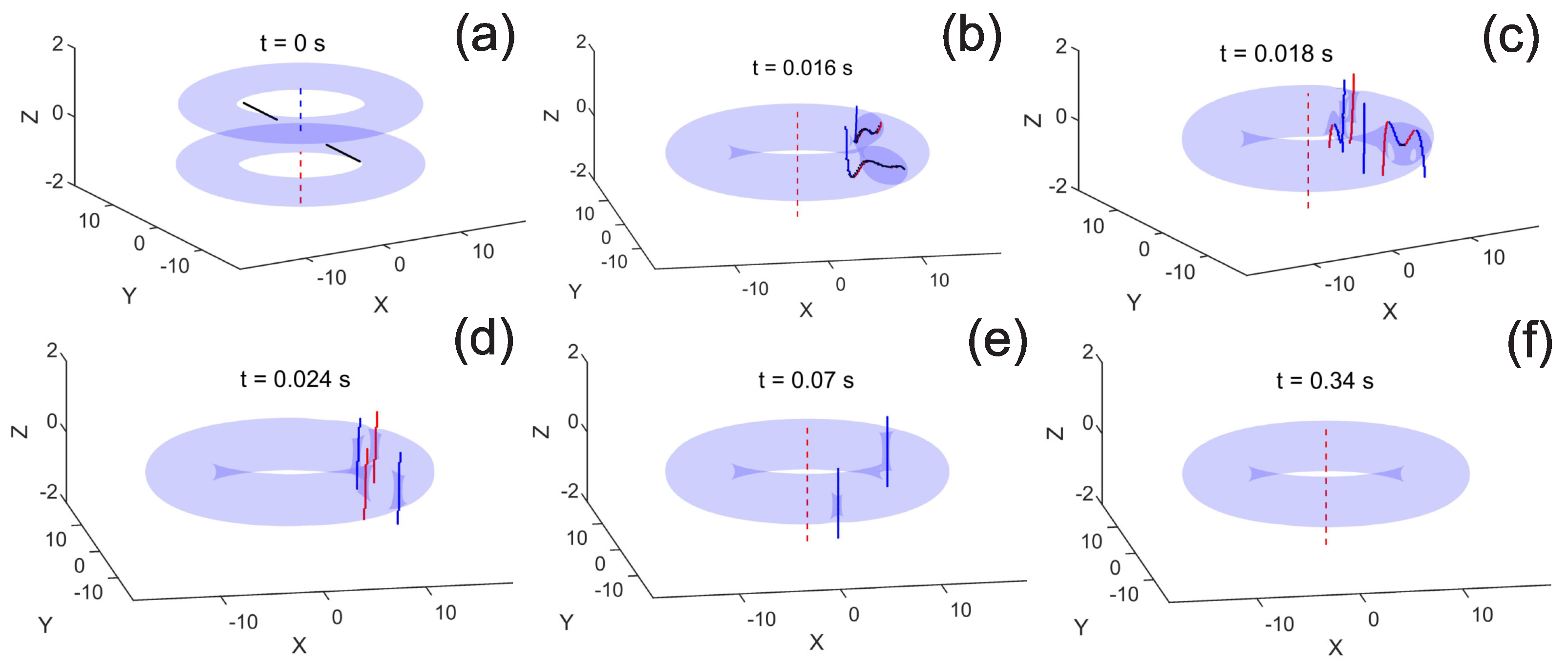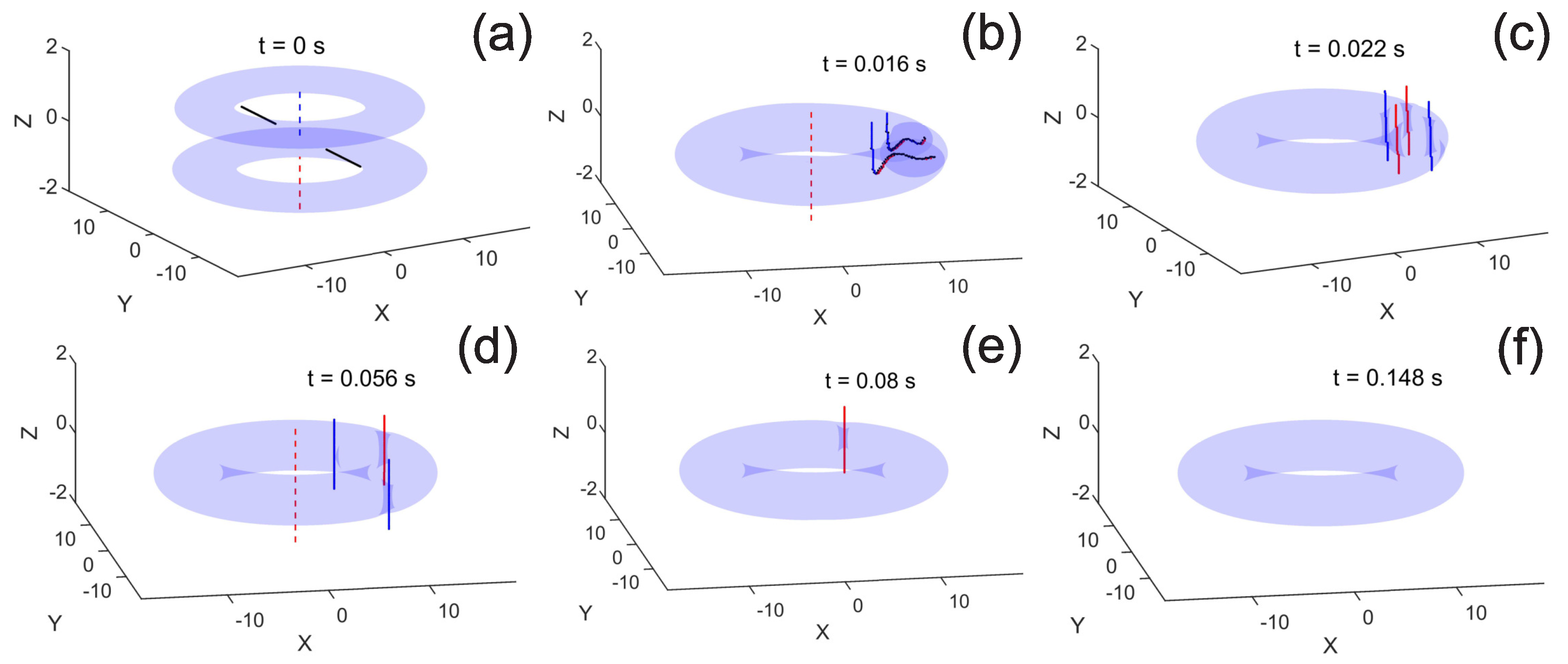Symmetry Breaking in Interacting Ring-Shaped Superflows of Bose–Einstein Condensates
Abstract
1. Introduction
2. The Model
3. Symmetry Breaking in Coupled Condensate Rings
3.1. Spontaneous Symmetry Breaking in a Stationary Hybrid Vortex Structure
3.2. Influence of the Symmetry on Dynamics of the Merging Rings
4. Conclusions
Author Contributions
Funding
Acknowledgments
Conflicts of Interest
References
- Brand, J.; Haigh, T.J.; Zülicke, U. Sign of coupling in barrier-separated Bose-Einstein condensates and stability of double-ring systems. Phys. Rev. A 2010, 81, 025602. [Google Scholar] [CrossRef]
- Brand, J.; Haigh, T.J.; Zulicke, U. Rotational fluxons of Bose-Einstein condensates in coplanar double-ring traps. Phys. Rev. A 2009, 80, 011602(R). [Google Scholar] [CrossRef]
- Su, S.W.; Gou, S.C.; Bradley, A.; Fialko, O.; Brand, J. Kibble-Zurek Scaling and its Breakdown for Spontaneous Generation of Josephson Vortices in Bose-Einstein Condensates. Phys. Rev. Lett. 2013, 110, 215302. [Google Scholar] [CrossRef]
- Baals, C.; Ott, H.; Brand, J.; Mateo, A.M. Nonlinear standing waves in an array of coherently coupled Bose-Einstein condensates. Phys. Rev. A 2018, 98, 053603. [Google Scholar] [CrossRef]
- Lesanovsky, I.; von Klitzing, W. Spontaneous Emergence of Angular Momentum Josephson Oscillations in Coupled Annular Bose-Einstein Condensates. Phys. Rev. Lett. 2007, 98, 050401. [Google Scholar] [CrossRef]
- Amico, L.; Aghamalyan, D.; Crepaz, H.; Auksztol, F.; Dumke, R.; Kwek, L.C. Superfluid qubit systems with ring shaped optical lattices. Sci. Rep. 2014, 4, 4298. [Google Scholar] [CrossRef]
- Aghamalyan, D.; Amico, L.; Kwek, L.C. Effective dynamics of cold atoms flowing in two ring shaped optical potentials with tunable tunneling. Phys. Rev. A 2013, 88, 063627. [Google Scholar] [CrossRef]
- Zhang, X.F.; Li, B.; Zhang, S.G. Rotating spin–orbit coupled Bose-Einstein condensates in concentrically coupled annular traps. Laser Phys. 2013, 23, 105501. [Google Scholar] [CrossRef]
- Polo, J.; Benseny, A.; Busch, T.; Ahufinger, V.; Mompart, J. Transport of ultracold atoms between concentric traps via spatial adiabatic passage. New J. Phys. 2016, 18, 015010. [Google Scholar] [CrossRef]
- Haug, T.; Amico, L.; Dumke, R.; Kwek, L.C. Mesoscopic Vortex-Meissner currents in ring ladders. Quantum Sci. Technol. 2018, 3, 035006. [Google Scholar] [CrossRef]
- Richaud, A.; Penna, V. Quantum dynamics of bosons in a two-ring ladder: Dynamical algebra, vortexlike excitations, and currents. Phys. Rev. A 2017, 96, 013620. [Google Scholar] [CrossRef]
- Gallemí, A.; Mateo, A.M.; Mayol, R.; Guilleumas, M. Coherent quantum phase slip in two-component bosonic atomtronic circuits. New J. Phys. 2016, 18, 015003. [Google Scholar] [CrossRef]
- Baggaley, A.W.; Parker, N.G. Kelvin-Helmholtz instability in a single-component atomic superfluid. Phys. Rev. A 2018, 97, 053608. [Google Scholar] [CrossRef]
- Kanai, T.; Guo, W.; Tsubota, M. Merging of Rotating Bose-Einstein Condensates. J. Low Temp. Phys. 2019, 195, 37–50. [Google Scholar] [CrossRef]
- Takeuchi, H.; Suzuki, N.; Kasamatsu, K.; Saito, H.; Tsubota, M. Quantum Kelvin-Helmholtz instability in phase-separated two-component Bose-Einstein condensates. Phys. Rev. B 2010, 81, 094517. [Google Scholar] [CrossRef]
- Suzuki, N.; Takeuchi, H.; Kasamatsu, K.; Tsubota, M.; Saito, H. Crossover between Kelvin-Helmholtz and counter-superflow instabilities in two-component Bose-Einstein condensates. Phys. Rev. A 2010, 82, 063604. [Google Scholar] [CrossRef]
- Montgomery, T.W.A.; Scott, R.G.; Lesanovsky, I.; Fromhold, T.M. Spontaneous creation of nonzero-angular-momentum modes in tunnel-coupled two-dimensional degenerate Bose gases. Phys. Rev. A 2010, 81, 063611. [Google Scholar] [CrossRef]
- Brtka, M.; Gammal, A.; Malomed, B.A. Hidden vorticity in binary Bose-Einstein condensates. Phys. Rev. A 2010, 82, 053610. [Google Scholar] [CrossRef]
- Wen, L.; Qiao, Y.; Xu, Y.; Mao, L. Structure of two-component Bose-Einstein condensates with respective vortex-antivortex superposition states. Phys. Rev. A 2013, 87, 033604. [Google Scholar] [CrossRef]
- Yakimenko, A.I.; Isaieva, K.O.; Vilchinskii, S.I.; Weyrauch, M. Stability of persistent currents in spinor Bose-Einstein condensates. Phys. Rev. A 2013, 88, 051602. [Google Scholar] [CrossRef]
- Ishino, S.; Tsubota, M.; Takeuchi, H. Counter-rotating vortices in miscible two-component Bose-Einstein condensates. Phys. Rev. A 2013, 88, 063617. [Google Scholar] [CrossRef]
- Ishino, S.; Tsubota, M.; Takeuchi, H. Matter-wave interactions in two-component Bose-Einstein condensates. EPL 2015, 111, 30005. [Google Scholar]
- Hoashi, M.; Nakamura, Y.; Yamanaka, Y. Analytical study of parameter regions of dynamical instability for two-component Bose-Einstein condensates with coaxial quantized vortices. Phys. Rev. A 2016, 93, 043622. [Google Scholar] [CrossRef]
- Xu, S.-L.; Wang, Z.-Q.; He, J.-R.; Xue, L.; Belic, M.R. Vector vortex solitons in two-component Bose-Einstein condensates with modulated nonlinearities and a harmonic trap. J. Mod. Opt. 2018, 65, 1542–1548. [Google Scholar] [CrossRef]
- Li, Y.; Chen, Z.; Luo, Z.; Huang, C.; Tan, H.; Pang, W.; Malomed, B.A. Two-dimensional vortex quantum droplets. Phys. Rev. A 2018, 98, 063602. [Google Scholar] [CrossRef]
- Leykam, D.; Malomed, B.; Desyatnikov, A.S. Composite vortices in nonlinear circular waveguide arrays. J. Opt. 2013, 82, 053610. [Google Scholar] [CrossRef]
- Salgueiro, J.R. Vector-vortex solitons in nonlinear photonic crystal fibers. J. Opt. 2016, 18, 074004. [Google Scholar] [CrossRef]
- Mayteevarunyoo, T.; Malomed, B.; Skryabin, D. Vortex modes supported by spin-orbit coupling in a laser with saturable absorption. New J. Phys. 2018, 20, 113019. [Google Scholar] [CrossRef]
- Oliinyk, A.; Yakimenko, A.; Malomed, B. Tunneling of persistent currents in coupled ring-shaped Bose-Einstein condensate. arXiv 2019, arXiv:1901.06502. [Google Scholar]
- Oliinyk, A.; Malomed, B.; Yakimenko. Nonlinear dynamics of Josephson vortices in merging superfluid ring. arXiv 2019, arXiv:1908.02468. [Google Scholar]
- Tsubota, M.; Kobayashi, M.; Takeuchi, H. Quantum hydrodynamics. Phys. Rep. 2013, 522, 191. [Google Scholar] [CrossRef]
- Yakimenko, A.I.; Bidasyuk, Y.M.; Prikhodko, O.O.; Vilchinskii, S.I.; Ostrovskaya, E.A.; Kivshar, Y.S. Optical tweezers for vortex rings in Bose-Einstein condensates. Phys. Rev. A 2013, 88, 043637. [Google Scholar] [CrossRef]
- Choi, S.; Morgan, S.A.; Burnett, K. Phenomenological damping in trapped atomic Bose-Einstein condensates. Phys. Rev. A 1998, 57, 4057. [Google Scholar] [CrossRef]
- Proukakis, N.P.; Jackson, B. Finite-temperature models of Bose-Einstein condensation. J. Phys. B At. Mol. Opt. Phys. 2008, 41, 203002. [Google Scholar] [CrossRef]
- Carretero-González, R.; Whitaker, N.; Kevrekidis, P.G.; Frantzeskakis, D.J. Vortex structures formed by the interference of sliced condensates. Phys. Rev. A 2008, 77, 023605. [Google Scholar] [CrossRef]
- Kasamatsu, K.; Tsubota, M.; Ueda, M. Vortex lattice formation in a rotating Bose-Einstein condensate. Phys. Rev. A 2003, 67, 033610. [Google Scholar] [CrossRef]
- Rooney, S.J.; Bradley, A.S.; Blakie, P.B. Decay of a quantum vortex: Test of nonequilibrium theories for warm Bose-Einstein condensates. Phys. Rev. A 2010, 81, 023630. [Google Scholar] [CrossRef]
- Wright, K.C.; Blakestad, R.B.; Lobb, C.J.; Phillips, W.D.; Campbell, G.K. Driving Phase Slips in a Superfluid Atom Circuit with a Rotating Weak Link. Phys. Rev. Lett. 2013, 110, 025302. [Google Scholar] [CrossRef]
- Jendrzejewski, F.; Eckel, S.; Murray, N.; Lanier, C.; Edwards, M.; Lobb, C.J.; Campbell, G.K. Resistive flow in a weakly interacting Bose-Einstein condensate. Phys. Rev. Lett. 2014, 113, 045305. [Google Scholar] [CrossRef]
- Driben, R.; Kartashov, Y.; Malomed, B.A.; Meier, T.; Torner, L. Three-dimensional hybrid vortex solitons. New J. Phys. 2014, 16, 063035. [Google Scholar] [CrossRef][Green Version]
- Arrautf, I. The Quantum Yang-Baxter Conditions: The Fundamental Relations behind the Nambu-Goldstone Theorem. Symmetry 2019, 11, 803. [Google Scholar] [CrossRef]
- Nambu, Y. Spontaneous Breaking of Lie and Current Algebras. J. Stat. Phys. 2004, 115, 7–17. [Google Scholar] [CrossRef]
- Brauner, T. Spontaneous Symmetry Breaking and Nambu–Goldstone Bosons in Quantum Many-Body Systems. Symmetry 2010, 2, 609–657. [Google Scholar] [CrossRef]
- Nielsen, H.B.; Chadha, S. On how to count Goldstone bosons. Nucl. Phys. B 1976, 105, 445–453. [Google Scholar] [CrossRef]
- Beattie, S.; Moulder, S.; Fletcher, R.J.; Hadzibabic, Z. Persistent Currents in Spinor Condensates. Phys. Rev. Lett. 2013, 110, 025301. [Google Scholar] [CrossRef] [PubMed]
- Yakimenko, A.I.; Vilchinskii, S.I.; Bidasyuk, Y.M.; Kuriatnikov, Y.I.; Isaieva, K.O.; Weyrauch, M. Generation and decay of persistent current in a toroidal Bose-Einstein condensate. Rom. Rep. Phys. 2015, 67, 249–272. [Google Scholar]





© 2019 by the authors. Licensee MDPI, Basel, Switzerland. This article is an open access article distributed under the terms and conditions of the Creative Commons Attribution (CC BY) license (http://creativecommons.org/licenses/by/4.0/).
Share and Cite
Oliinyk, A.; Yatsuta, I.; Malomed, B.; Yakimenko, A. Symmetry Breaking in Interacting Ring-Shaped Superflows of Bose–Einstein Condensates. Symmetry 2019, 11, 1312. https://doi.org/10.3390/sym11101312
Oliinyk A, Yatsuta I, Malomed B, Yakimenko A. Symmetry Breaking in Interacting Ring-Shaped Superflows of Bose–Einstein Condensates. Symmetry. 2019; 11(10):1312. https://doi.org/10.3390/sym11101312
Chicago/Turabian StyleOliinyk, Artem, Igor Yatsuta, Boris Malomed, and Alexander Yakimenko. 2019. "Symmetry Breaking in Interacting Ring-Shaped Superflows of Bose–Einstein Condensates" Symmetry 11, no. 10: 1312. https://doi.org/10.3390/sym11101312
APA StyleOliinyk, A., Yatsuta, I., Malomed, B., & Yakimenko, A. (2019). Symmetry Breaking in Interacting Ring-Shaped Superflows of Bose–Einstein Condensates. Symmetry, 11(10), 1312. https://doi.org/10.3390/sym11101312





